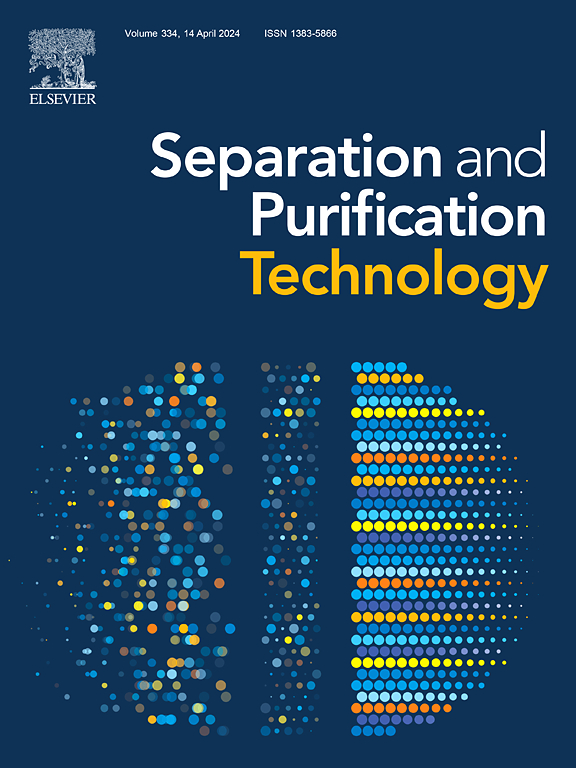TiO2-Bi2Sn2O7负载木材按需油水分离,同时有效降解AO7
IF 9
1区 工程技术
Q1 ENGINEERING, CHEMICAL
引用次数: 0
摘要
持续排放含有机含油废水导致的环境危机不断升级,需要革命性的解决方案来同时实现油水分离和污染物降解的双重功能。传统的分离膜在解决这些相互交织的挑战方面表现出根本性的局限性。我们通过战略性地改造天然木材,开创了开创性的生物质衍生声催化/光催化平台。我们通过水热合成Bi2Sn2O7纳米粒子,并对其进行精确的TiO2修饰,构建了二氧化钛-Bi2Sn2O7纳米粒子,并通过喷雾沉积技术将其无缝集成到木材基体中。利用木材独特的各向异性孔隙度和环保特性,我们的仿生设计实现了前所未有的性能:强大的疏水性,卓越的油水分离效率(15个严格循环后保持97%的保留率),以及卓越的环境弹性,在极端条件下保持功能。最引人注目的是,我们开发了一种刺激响应系统,其中丙烯酸功能化可以在疏水/亲脂和亲水/疏油状态之间动态,可逆地切换-这是适应性废水处理的关键进展。设计的智能木具有优异的水下疏油性(去除角为146.3 ± 2.74°)和协同声催化降解能力(超声作用下60 min可去除95% %的AO7染料)。这项工作为可持续水净化技术建立了一个新的范例,展示了木材作为多功能平台的变革潜力。我们的二氧化钛- bi2sn2o7木材复合材料代表了废水处理的巨大飞跃,提供智能按需分离,同步污染物矿化和可扩展的绿色制造,解决了当前环境修复策略的关键空白。本文章由计算机程序翻译,如有差异,请以英文原文为准。


TiO2-Bi2Sn2O7 loaded wood for on-demand oil–water separation while efficiently degrading AO7
The escalating environmental crisis caused by persistent discharge of organic-laden oily wastewater demands revolutionary solutions integrating dual functionality for simultaneous oil–water separation and pollutant degradation. Conventional separation membranes exhibit fundamental limitations in addressing these intertwined challenges. We pioneer a groundbreaking biomass-derived sonocatalytic/phptocatalytic platform by strategically engineering natural wood. Through hydrothermal synthesis and precise TiO2 modification of Bi2Sn2O7 nanoparticles, we constructed TiO2-Bi2Sn2O7, which were seamlessly integrated into the wood matrix via spray deposition technology. Capitalizing on wood’s unique anisotropic porosity and eco-friendly characteristics, our bio-inspired design achieves unprecedented performance that robust hydrophobicity, exceptional oil–water separation efficiency (97% retention after 15 rigorous cycles), and remarkable environmental resilience maintaining functionality under extreme conditions.
Most strikingly, we developed a stimuli-responsive system where acrylic acid functionalization enables dynamic, reversible toggling between hydrophobic/lipophilic and hydrophilic/oleophobic states − a critical advancement for adaptive wastewater treatment. The engineered smart wood possessed superior underwater oleophobic (146.3 ± 2.74° removal angle), and synergistic sonocatalytic degradation (95 % AO7 dye elimination in 60 min under ultrasonication). This work establishes a new paradigm for sustainable water purification technologies, showcasing wood’s transformative potential as a multifunctional platform. Our TiO2-Bi2Sn2O7 wood composite represents a quantum leap in wastewater treatment, offering intelligent on-demand separation, simultaneous pollutant mineralization, and scalable green manufacturing-addressing critical gaps in current environmental remediation strategies.
求助全文
通过发布文献求助,成功后即可免费获取论文全文。
去求助
来源期刊

Separation and Purification Technology
工程技术-工程:化工
CiteScore
14.00
自引率
12.80%
发文量
2347
审稿时长
43 days
期刊介绍:
Separation and Purification Technology is a premier journal committed to sharing innovative methods for separation and purification in chemical and environmental engineering, encompassing both homogeneous solutions and heterogeneous mixtures. Our scope includes the separation and/or purification of liquids, vapors, and gases, as well as carbon capture and separation techniques. However, it's important to note that methods solely intended for analytical purposes are not within the scope of the journal. Additionally, disciplines such as soil science, polymer science, and metallurgy fall outside the purview of Separation and Purification Technology. Join us in advancing the field of separation and purification methods for sustainable solutions in chemical and environmental engineering.
 求助内容:
求助内容: 应助结果提醒方式:
应助结果提醒方式:


